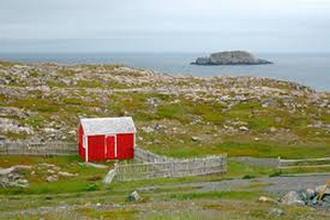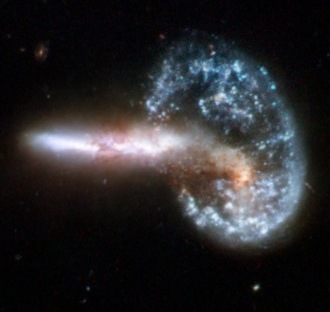Fun fact: everything and everyone is eventually going to die. Not to kill your buzz or anything, but have you ever stopped to think about that? Everyone you meet today is going to someday be a corpse. Every tree you ever climbed is going to be reduced to nothing. Every flower you sniffed is just going to stop being. That pretty much blows, right?
What blows even harder are the odds that we human beings could potentially be wiped out a the same time, causing human extinction. What’s more, we don’t know when or how it’s going to happen, but we do know that it could happen in a variety of exciting and terrifying ways. What follows is an attempt to try and generalize our eventual demise into four categories.
1.
Nuclear War

There are some who say that humankind’s greatest invention is war. These people have clearly never played a Super Nintendo, but we digress. The event of war spurs production, which in turn spurs invention, almost always of weapons but sometimes of tiny snack cakes or other cool stuff. As a general rule of thumb, modern warfare is won by whoever could potentially mess the most shit up. This can be further broken down into whoever has the deadliest weapon or arsenal. It’s basic playground rules: the biggest kid gets to play on the slide and the rest get a punch in the gut.

Monster.
There have only ever been two nuclear weapons used during wartime in history and since their use there has been a great effort made to ensure that they are controlled and regulated to prevent a large scale nuclear conflict. In 1985, there were an estimated sixty-five thousand nuclear weapons in the world. Now that number is significantly lower at around eight thousand. However, there’s no reliable means to determine who has nuclear weapons. A rouge nation with nuclear weapons could prove disastrous for the rest of the world; a method of retaliation called mutual assured destruction could see more nuclear weapons used in response to a single detonation, triggering even more attacks and defense systems to fire. Even more worrisome, some systems are automatic, known as fail-deadly, and automatically release a payload if one of the sensors is triggered. They don’t teach you that in Stratego.
2.
Population Crisis

Scenario: enter an elevator with a group of three of your friends and situate yourselves so that you’re all comfortable. Then ride the elevator all day, accepting new passengers but never leaving the elevator. If you’re doing this properly, things are going to get uncomfortable quickly and someone is going to get desperate for space. Again, if things are going according to plan, someone’s going to throw a punch. A few minutes later, emergency personnel are going open your elevator to find one person standing amongst a group of bloodied corpses. End scenario, start life sentence.
The 1900s saw a sharp increase in the growth of human population, which is currently racing towards seven billion people. The problems with this are obvious; resources on our planet are very limited. Land, food and water will become increasingly scarce as the number grows. Though not an immediate issue, overpopulation could potentially lead to famine and mass starvation. A lack of land resources could trigger warfare.

A similar problem that isn’t addressed as often is underpopulation, where the rate of human population hits a steady and continuous decline. This can be caused by the reasons mentioned above as well as the choices we make as a society. Political policies that limit the number of children a family can have (currently in place in China) may be used as a population control mechanism but eventually force the population into decline. Natural defects can affect fertility, causing the rate of children to be born to be lessened and weakening subsequent generations as a result. Underpopulation causes a “soft” extinction, taking several hundred or even thousand years to take place.
3.
At the Hands of Earth

Historically, planet Earth has been known to throw temper tantrums from time to time and completely wipe out entire species as a result. These events (charmingly referred to as doomsday events) tend to happen in large cycles. Take the ice age, for example. The ice age is usually vaguely defined as a single event that killed all those cavemen, or something. In actuality, there have been twelve ice age events throughout history. They’re believed to happen every forty to ten-thousand years. So that’s probably not something you should lose any sleep over.

But it is coming. Ever so slowly, just like diabetes.
If you’re looking for something a little more pending and far less predictable, consider global pandemics. The mutation of a contagious disease paired with overpopulation can (and has) killed millions. In the late 1800s a plague pandemic originating in China passed through several countries, killing millions (ten million alone in India) and not stopping until the 1950s. In order for a pandemic to be slowed down and eventually stopped, the disease needs to stop mutating and adapting, medical research needs to advance quickly and travel needs to be tightly monitored. In the case of China’s outbreak, the disease was able to reach over twenty countries simply by boats. With modern methods of transportation, travel is much faster and difficult to restrict. In short, we’re doomed.
4.
At the Hands of the Universe

Perhaps the biggest threat to our survival is that which we understand the least. There’s an entire field of scientific study dedicated to theorizing just how many different ways the universe has to shank everything that dwells within it. If such an event did occur we would very much be powerless to stop it, so have fun with that.

A commonly discussed method of destruction is heat death, where the universe has depleted its thermodynamic free energy and thus can’t sustain any living life as the temperature approaches and comes very close to absolute zero. The effect is similar to the cold death theory, in which continued expansion of the universe causes the temperature to drop to a point where life stops. Despite sounding eerily similar, these two events are very different. Of course, you’re not going to be able to tell the difference once you stop existing anyway.

The Big Rip (tee-hee!) theorizes that an infinite universe that is constantly expanding will eventually tear apart everything within it, from stars to planets. Inversely, the Big Crunch speculates that the expanding universe may reach a point where the expansion is reversed, eventually creating a black hole to consume everything. It may then reverse again, causing another Big Bang, but you’re not going to be around to appreciate that particular sight.
Written by NN – Copyrighted © www.weirdworm.net Image Sources
Image sources:
- – Nuclear War: http://i109.photobucket.com/albums/n80/ChainsawDoom/mushroomcloud2-2.jpg http://img.dailymail.co.uk/i/pix/2007/10_04/bullyL2810_468x350.jpg
- – Population Crisis: http://www.bagatellen.com/images/waldo2.jpg http://t0.gstatic.com/images?q=tbn:ANd9GcRaQn8F1-1Cd27KK3Tkx9Yj4oqzdziUOCuZasXNAl7ROV-O-rg&t=1&usg=__acEs0gy20PF4X5RTm-P1MDl9mGU=
- – At the Hands of Earth: http://poesianocaos.files.wordpress.com/2009/03/imp63-copy.jpg?w=400&h=300 http://t3.gstatic.com/images?q=tbn:ANd9GcR0sBG8Pw1Iq23Ca6-sqyk1O3GBCBeQ7SDh6DBCcULxwZniU0g&t=1&usg=__6Pvq0RQA2nw5I5lkJeW2DH9MNow=
- – At the Hands of the Universe: http://img.yaplog.jp/img/02/pc/2/0/0/2009-10-31/4/4438.jpg http://t1.gstatic.com/images?q=tbn:ANd9GcSD6fl20vLbrA2NnrjeUDWEj–iJen_ASqaNwXGemkWwC-aeX8&t=1&usg=__d3uUXHHV5tfGTl-kQgJsqYd9ffc= http://t0.gstatic.com/images?q=tbn:ANd9GcSu3n-DMx2oKUo47nI8fuoiKM6NYZvH46Ah5MmPhwZaIcFaqYQ&t=1&usg=__ZQBau2V0YUYA1p0HsIC0OU5whAc=







